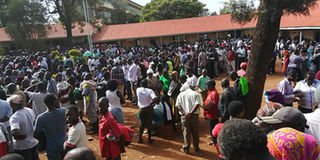Safety reports gather dust as schools become ‘death camps’

Anxious parents gather at Kakamega Primary School on February 4, 2020 after a stampede killed 14 pupils. PHOTO | CAROLINE WAFULA | NATION MEDIA GROUP
What you need to know:
- Education stakeholders are calling on the government to address the issue of infrastructure and teacher shortage to ensure learners’ safety.
- Mr Jonathan Wesaya, an education specialist, said disasters continue to occur in schools due to failure by the government to take action against its field officers.
Two crucial documents developed by the government on safety in learning institutions continue to gather dust as the Ministry of Education dithers on their implementation.
The Safety Standards Manual for Schools in Kenya (2008) and a task force report on school unrest in 2017 detail how the government should ensure safety of learners in schools.
The tragic death of 14 pupils at Kakamega Primary on Monday add to the growing list of learners who have died in schools, a place they are supposed to be safe, despite assurance by Education Cabinet Secretary George Magoha that the children are safe.
With 100 per cent transition from primary to secondary schools now in its third year, education stakeholders are calling on the government to address the issue of infrastructure and teacher shortage to ensure learners’ safety.
The Kenya Union of Post Primary Education Teachers (Kuppet) secretary-general, Akelo Misori, said the government must strictly enforce the Safety Standards Manual for Schools in Kenya (2008).
“A study we conducted last year revealed that non-enforcement of the existing policy standards has left schools vulnerable to basic safety hazards,” Mr Misori said.
He wondered how many children must die for the government to create a body to review and harmonise all policy instruments and guidelines relating to safety, security and disaster management in the education sector.
Mr Jonathan Wesaya, an education specialist, said disasters continue to occur in schools due to failure by the government to take action against its field officers.
“We have field officers in the directorate of quality assurance and standards who are supposed to be checking these facilities frequently but they are not doing so. They only emerge during a disaster,” Mr Wesaya said.
Fire outbreak
Kenya Secondary School Heads Association (Kessha) chairman, Kahi Indimuli, said calamities in schools can only be avoided if infrastructure and enough teachers are available.
“We need enough teachers to manage these learners. With 100 per cent transition, the available teachers may not be effective since they also have other responsibilities,” said Mr Indimuli. He added that many schools do not have enough dormitories, classrooms and toilets, making the learning environment unfriendly.
Strained
Teachers Service Commission (TSC) secretary and chief executive officer, Nancy Macharia, acknowledges that the in-creased enrolment in public secondary schools has strained the existing teachers with increased workload.
Mr Misori said schools are fast becoming death camps and only an overarching policy will save learners and teachers from stampedes, accidents, building collapses and terrorists.
A report compiled by a special investigation team, which was led by former provincial administrator Claire Omollo in 2017, pointed out that most schools did not have the necessary safety policy.
“The inadequate preparation for fire disasters has led to inability to salvage students’ and school property leading to loses even in cases where such loses could have been prevented. This situation was found to be risky to the lives of students in the event of fire outbreak,” the report noted.
Several principals who spoke to the Sunday Nation said the government appears to have abandoned the implementation of the report as it has cost implications.
The Safety Standards Manual for Schools provides that every school should post a blueprint map of the buildings, classrooms, dormitories and hallways.
The safety measures by the ministry include installation of serviceable fire-extinguishing machines, good security arrangements with provision for both night and day, well-maintained and clean learning rooms, a properly reinforced fence with an appropriate mechanism for repair and maintenance.
The guidelines also provides that there should be inspection of hygiene standards of the dormitories and the learners on alternate days of the week.





